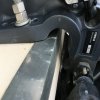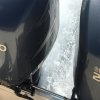The hole used is not an absolute reference. The initial rigging position, according to the Yamaha rigging guide::For planing boats, the anti-cavitation plate should be positioned to the boat transom bottom or slightly higher" ( for displacement hulls the cav plate should be even to 1 inch lower than the transom bottom edge at the center line of the motor)
Toe out should be checked too. One way to get an idea if your toeout is close to spec is to look at the wakes of the motors . The wakes should run into each other (merge) at about 25 to 50 feet behind the boat at cruise.
The settings of trim tabs can greatly affect the ride height of the boat/motor so just looking at where the cavplate is may not tell the complete story.Often fine tuning the tabs has more effect than raising or lowering the motors mounting hole. Finally, this is true especially for lighter and smaller hulls,when someone goes aft to look at the cav plate under speed, the added weight of that person can affect the plates depth.
The bottom line is that it is not easy to just look and determine if the mounting height is optimal. Although trial and error can help, it is a pain to have to readjust the mounting height.
The better approach is to ask similar boat owners what the measurement is from the cav plate to the bottom edge of the transom ( even, lower or higher and by how much) with the motors trimmed parallel to the transom. Find out what their goals on performance are, they may be different from yours. Perhaps hole shot performance is important, maybe its cruising efficiency. Ask what props are rigged and how happy the captain is with the setup.



